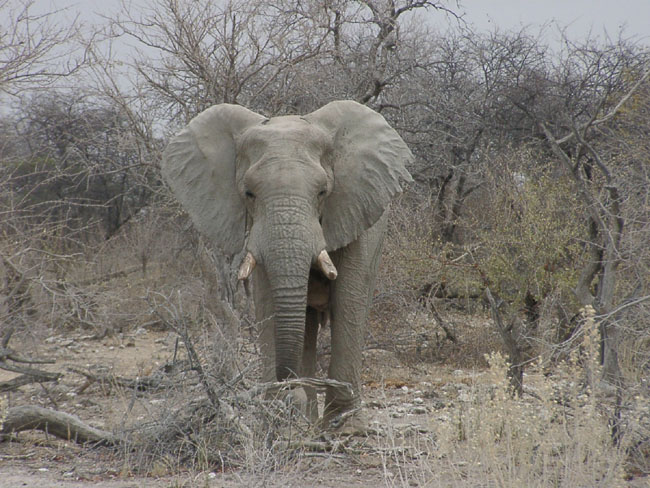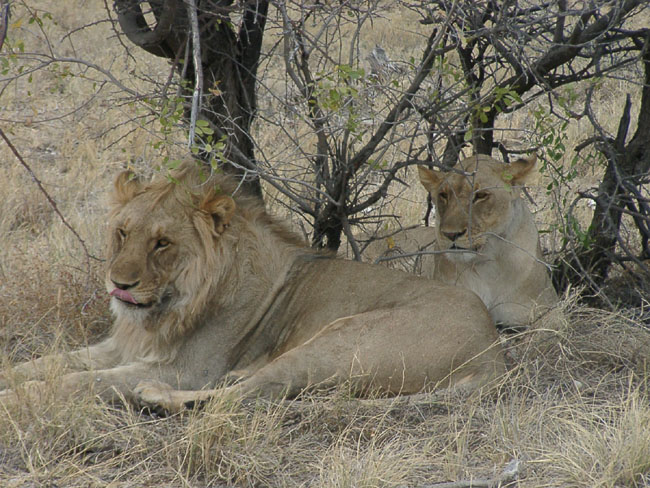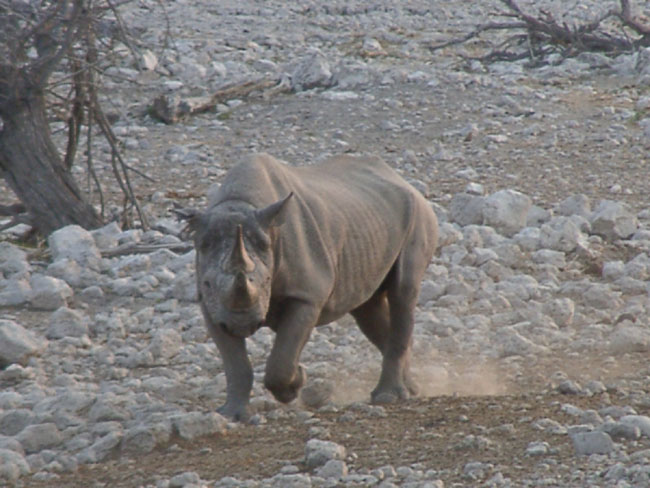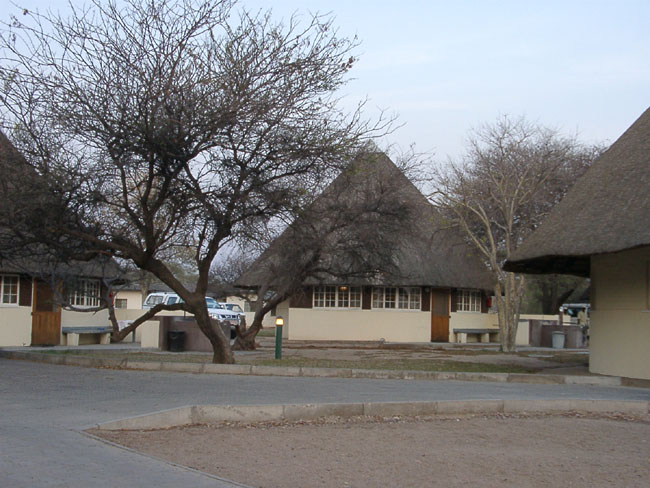| «Back to Previous Post |
Date: Thursday, 23 October 2003 06:40 PDT
Subject: Greetings from the Kalahari Desert
Captions for photos:
1. Lone bull elephant (Etosha NP)
2. Male and female lion (Etosha NP)
3. Black rhino (Etosha NP)
4. Rondaval and rental car (Etosha NP)
5. Darren and kids (Cardboard box, Windhoek, Namibia)
15 October 2003 – Day #25
We are currently crossing the Kalahari Desert. The distance from Windhoek, Namibia to Maun, Botswana is 896 km and will take nine hours. Our driver’s name is Mahimbia. He passes the time by singing to the native African music playing in the tape deck in our double cab Nissan 4×4. Right now, the terrain looks like the desert on the way to Las Vegas. The only difference is on that stretch you don’t see baboons as we have. Later, it will become more desolate – a pan flat with no vegetation.
Last time you heard from us, we were on our bus ride from Cape Town to Windhoek, Namibia. We left Cape Town at 10am and arrived in Windhoek at 7am the next morning. We had prearranged a hostel room and a rental car via the Internet before we left the States.
We relaxed during the day and got caught up on the kids’ homework. At 4:30, we picked up the rental car. The day we arrived was the Hostel’s 10th anniversary. That night, they threw a big party treating the guests and other locals with free food and games. The free food consisted of lamb, chicken, homemade sausage and salad. The lamb was cooked whole over a pit of hot coals.
We awoke at 6am the next morning, packed and took off to the North to Etosha National Park. It is 475 km to the gate. Etosha is 250 km south of the Angolan border. It is the dry season. The surrounding plants and trees are leafless and look dead. The wet season will begin soon and the desert will bloom for a few months until the cycle repeats itself again.
The roads in Namibia are all designated with a letter and a number. The letter indicates the type of road: B (interstate), C (minor road – paved), D (minor road – gravel), FM (farm road) and P (private). Most of the roads in the park and in the North are D roads. As such, Namibia is 4×4 heaven for those so inclined. Though we rented a 4×4, 4-wheel drive isn’t needed in the park until the wet season.
Etosha is huge. It is 22,000-sq. km. – about 100 miles wide by 50 miles high. As we drove on the roads in the park, we rarely saw other cars. We did see others at the park’s 50 natural and man-made water holes.
We spent 3 nights in the park staying at lodges as we migrated from West to East. The lodges are virtually the only development in the park. Each are fenced or walled with one or more gates. Driving before sunrise or after sunset was prohibited. The gates were locked at nights to ensure this rule is followed and to protect the guests (we weren’t able to get out of our car after we left the lodges). All the lodges were the same – reception office, gift shop, market and about 50 bungalows.
Etosha is known for its abundant wildlife. While there, we saw hundreds of dik diks (look like a small deer), springbok (slightly larger with a black stripe on its belly) and zebra. We saw around 70 elephants and 50 giraffes. The baby elephants were so cute. We also saw warthogs, jackals and vultures. One of the highlights of our visit was seeing a black rhino (rare) at one of the waterholes. We were also very fortunate to see a male and female lion resting on the side of the road (only 10 feet from our vehicle).
Miss you all.
God’s Blessings,
Darren
| «Back to Previous Post |





